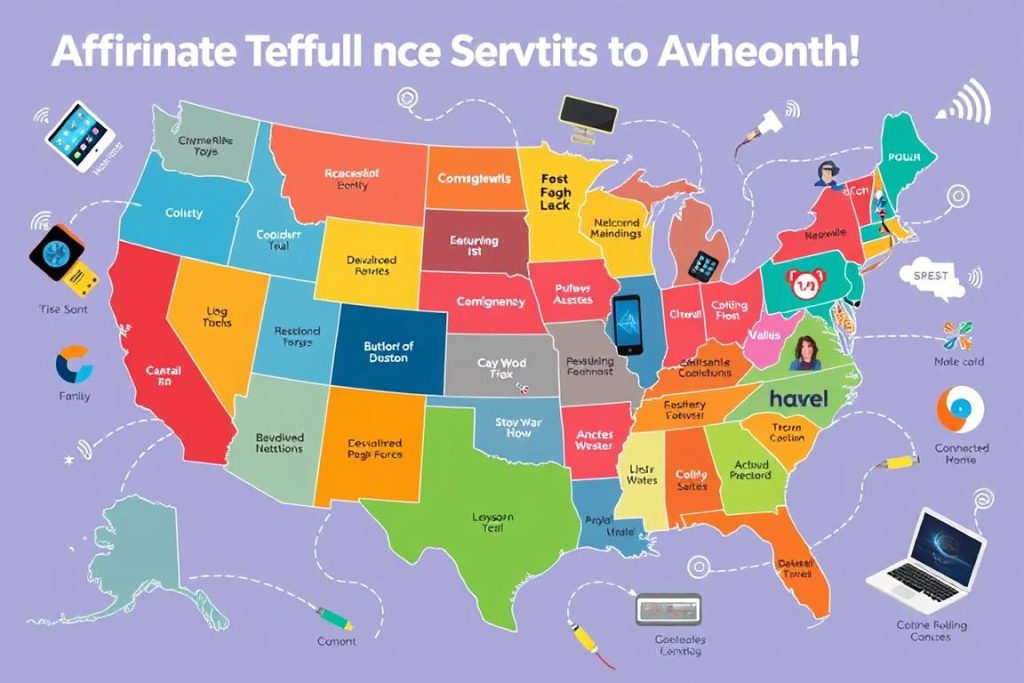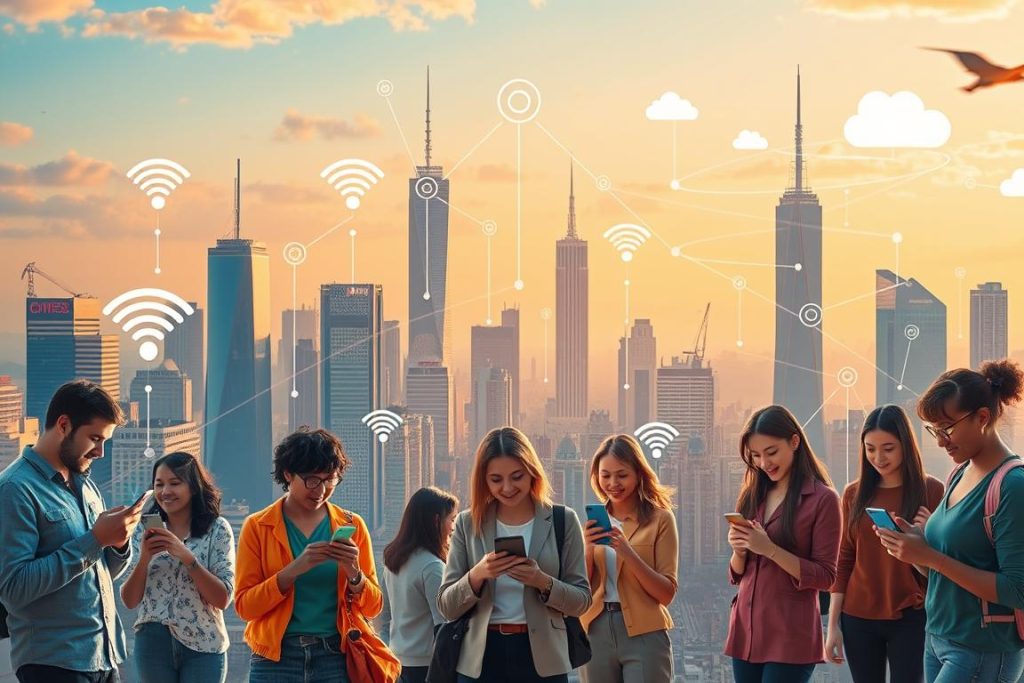After the Affordable Connectivity Program (ACP) ended, many people were left worried. They feared losing connection to the world and missing out on important chances. Yet, there’s still hope for free internet access through phone and tablet programs. In the US, 50 million homes find it hard to pay for things like their phone bill1. But don’t lose hope. There are still free digital tools available, even without the ACP.
Getting connected shouldn’t mean dealing with hidden costs. Many don’t see the hidden fees in long contracts from big carriers1. But you’re not out of options. Free Phone Wireless offers help to those who qualify, with free phones or tablets. They also give free data, text, and talk each month12. Sometimes, getting a tablet may only cost you $10.011.
Free Phone Wireless is all about helping their customers. They’re based in New Orleans, Louisiana, and offer help in many languages, ready to support you anytime1. Check if you qualify by looking at certain requirements. These might include earning below 135% of the federal poverty line or being part of programs like SNAP or Medicaid23. With devices like the iPhone 7 and Samsung Galaxy tablets, staying connected isn’t just for those who can afford it. It’s something everyone deserves23.
Key Takeaways
- Seek out free phone and tablet programs for continued digital engagement post-ACP.
- Discover no-cost internet access solutions tailored to low-income individuals and households.
- Understand how nonprofit organizations and Federal Lifeline program provide essential digital tools.
- Remember that broadband affordability doesn’t end with ACP; alternatives abound.
- Utilize local ISPs and statewide initiatives to find cost-effective tech resources.
- Inquire about subsidies that could ease the financial burden of connectivity.
Understanding the Impact of the ACP Termination on Internet Access
The end of the Affordable Connectivity Program (ACP) marks a pivotal moment for U.S. broadband access, deepening the digital divide for millions. As funds run out by April 20244, the search for new solutions becomes urgent.
The Digital Divide Post-ACP: Assessing the Situation
More than 11.5 million households relied on the ACP for affordable internet5. The ending of ACP highlights the need for continued broadband services and mobile device programs. The digital divide grows as essential online services slip out of reach for low-income families.
Households will see their internet bills go up by $30/month after ACP ends4. This pushes them towards more limited and unreliable internet options.
Whoop Connect sees the challenge ahead and is helping customers find lasting broadband solutions as the ACP ends.
Federal Lifeline Program: An Alternative to ACP
The Federal Lifeline program provides a glimmer of hope. It offers up to $34.25 monthly for broadband on tribal lands, and $9.25 in other areas5. This aid is crucial for those meeting specific income criteria or enrolled in certain federal programs.
Local ISPs Offering Continuation of Discounts
Even with ACP ending, ISPs like Brightspeed and Kinetic by Windstream are stepping up. They’re continuing $30 monthly discounts for qualified customers4. Such actions are vital for maintaining internet access for those in need.
Engaging with ISPs and staying informed about available discounts is important. This will help consumers navigate changes in internet service offerings.
Though ACP’s end brings challenges, the collective efforts from community programs, government subsidies, and ISPs can soften the blow for the most vulnerable. Being informed and connected to resources is crucial during this transition to new digital connectivity solutions.
Exploring State-Specific Solutions for Affordable Connectivity
The digital world is growing, and many U.S. states are finding unique ways to keep up. They’re rolling out state-specific internet options to help people reach online resources. These efforts come after changes in the national Affordable Connectivity Program (ACP). They’re key in closing the digital divide and bringing affordable connectivity solutions to communities that need them most6.
States like Alabama, Alaska, and Arizona are creating unique plans for low-income families. Providers like AT&T and Mediacom have customized programs. They focus on the special needs of these areas, offering lower prices and more data7.
Local projects, such as Connect Arizona, are advancing by mixing in educational efforts. They reduce service costs and teach the value and need for internet access7. Spectrum Internet Assist gives a good model with its $15-monthly-plan. This plan includes a free modem and doesn’t limit data, aiming to help low-income families6.

There are also discounts and subsidies, aimed at groups like military families, to make the internet widely affordable. To get these benefits, families must show they qualify based on income. This ensures the internet is seen as a necessary service, not a luxury6.
Here’s a summary of the affordable connectivity solutions found in some states. It shows the variety and impact of these efforts:
| State | Program | Cost | Eligibility Requirements |
|---|---|---|---|
| Alabama | AT&T Low-Income Plan | $10/month | Income below 200% of Federal Poverty Level |
| Alaska | Mediacom Connect2Compete | $15/month | Families with children in K-12 |
| Arizona | Connect Arizona Initiative | $20/month | Proof of residency, income verification |
| Nationwide | Spectrum Internet Assist | $15/month | Eligibility for NSLP, SSI or Public Housing |
State-specific internet options support individuals and families in need of low-income internet programs. They also enhance a community’s growth by giving access to education, jobs, health info, and more. These state-level efforts show a commitment to ensuring all Americans can participate in our digital world7.
Free phone and tablet programs: Bridging the Tech Gap with No-Cost Options
Many communities face the challenge of the digital divide. Free and low-cost telecom programs are important. They ensure everyone gets the tech they need. This help goes to low-income families, students, and others who are at a disadvantage.
Navigating Free and Low-Cost ISP Initiatives
There are many programs that help with internet costs. For example, Xfinity’s Internet Essentials and Cox’s ConnectAssist offer high-speed internet at low costs. These make it easy to download apps and keep smartphones updated8. Also, Verizon Forward and Xfinity Internet Essentials can cut monthly internet bills by up to $30. This makes the web more affordable for a lot of people8.
Nonprofits and Community Resources Offering Digital Tools
Nonprofits in the US are huge in tech assistance. Organizations like Human-I-T and EveryoneOn provide cheap connectivity and devices. EveryoneOn, for example, has low-priced computers and internet deals. They help people in need get digital tools9.
Some initiatives give out free tablets and phones to people in government programs. This allows them to use important online services. These include educational platforms and telehealth9.
Lifeline and Other Government-Assisted Programs
Government programs play a big role in making broadband affordable. Lifeline gives a discount of at least $9.25 a month on broadband for those who qualify. This helps close the digital divide8. In Chicago, there’s a program called Chicago Connected. It gives free internet to qualifying families from local schools. This ensures students can use the apps and tools they need for school8.
The Lifeline program also helps families get tablets at a low cost or for free. These devices are a big help for children from low-income homes. They use these for learning9.

Building digital inclusion is about more than just cheap plans or many hotspots. It takes work from ISPs, community groups, and government efforts. They all work together to provide both internet access and devices. These efforts are slowly closing the gap in digital access. They ensure everyone can use the internet and digital tools to their full advantage.
Conclusion
Understanding if you qualify for free phone and tablet programs is crucial in today’s digital world. This is true whether your income meets the Federal Poverty Guidelines for a free device from Safelink Wireless, Q Link Wireless, or Assurance Wireless1011. Or if you’re looking into affordable broadband access through the FCC’s Lifeline program or the Biden Administration’s efforts12. Being aware of these options helps avoid being left behind in the digital era.
It’s not all about government help though. Local ISPs also offer discounted services. These, along with federal efforts, aim to support education, employment, and health care through tech10. Now, getting digital tools is easier than ever. But, the time to get these benefits can vary. It might take from a few days to weeks after applying1011.
Using these resources also boosts mobile application development. This increases demand for more accessible designs and services for everyone. By engaging with these programs, you grow personally and provide useful feedback. This feedback helps make technology more inclusive for everyone12. By seeking out these tech tools, you improve your digital skills. At the same time, you support the goal of universal affordable connectivity.
FAQ
What are some free phone and tablet programs available without ACP?
How has the ACP termination affected broadband affordability?
What is the Federal Lifeline Program and how can it help with internet access?
Are there local ISPs still offering discounts on internet service?
What state-specific internet options are available for affordable connectivity?
How can I bridge the tech gap with no-cost options?
Which nonprofits and community resources offer digital tools and assistance?
How do I qualify for Lifeline and other government-assisted programs?
Can I still download apps and use smartphone software without incurring high costs?
Source Links
- Free Smartphone | Free Talk, Text, and High-Speed Data | Free Phone Wireless | New Orleans, LA – https://www.freephonewireless.org/
- How to Get a Free Government iPhone and Tablet: Your Ultimate Guide – https://www.linkedin.com/pulse/how-get-free-government-iphone-tablet-your-ultimate-guide-problem-ngfnc
- Get A Free Government Phone And Tablet With Unlimited Data – https://www.linkedin.com/pulse/get-free-government-phone-tablet-unlimited-data-kazi-arsadul-alam-72vtc
- The Affordable Connectivity Program (ACP) is Ending: Your Internet Options – https://www.sjpl.org/blogs/post/the-affordable-connectivity-program-acp-is-ending-your-internet-options/
- New Federal Benefit Provides Affordable Broadband Access – https://library.nclc.org/article/new-federal-benefit-provides-affordable-broadband-access
- Access Free Government Phone And Tablet with Unlimited Data Service – https://www.linkedin.com/pulse/access-free-government-phone-tablet-unlimited-data-service-mozumdar-7erdc
- How to qualify for free tablet from government – https://www.linkedin.com/pulse/how-qualify-free-tablet-from-government-the-isp-info-dwblc
- Free Government Tablet – With EBT 2024 – https://strippedfilm.com/free-government-tablet/
- Lifeline Free Tablet: A Comprehensive Guide – https://www.linkedin.com/pulse/lifeline-free-tablet-comprehensive-guide-device-problem-3la7c
- Free Government Phone and Tablet Combo: Your Ultimate Guide – https://www.linkedin.com/pulse/free-government-phone-tablet-combo-your-ultimate-guide-md-rafiqul-2hfdc
- Free Government Phone and Tablet in 2024 – https://www.linkedin.com/pulse/free-government-phone-tablet-2024-enamul-haque-0hhec
- The Affordable Connectivity Program Was a Connectivity Lifeline for Millions. Congress Is Letting It Die – The Markup – https://themarkup.org/still-loading/2024/05/04/the-affordable-connectivity-program-was-a-connectivity-lifeline-for-millions-congress-is-letting-it-die

